Does your mozzarella refuse to stretch or just burn? The secret is science. From "pasta filata" to the crucial role...
Comprehensive Guide to Bee Migration Management for Beekeepers
introduction
Migration is one of the methods that beekeepers use to make more use of nectar-producing or pollen-producing plants, produce quality honey, and strengthen their colonies. In this method, beekeepers regularly move their colonies to different areas based on the season and ecological conditions. This gives the bees good access to diverse and abundant food sources, and as a result, the production of honey and royal jelly, pollination, and the growth of their population increases. has it. Otherwise, it may cause problems and risks to the health and performance of bees. Some of these problems are
- Loss or theft of colonies
- Emergence of diseases and pests in colonies
- Tolerance of stress due to transportation
- Competition with other bees or dangerous insects
- Inability to adapt to the geographical conditions and climate of the new area
- Lack of access to sufficient or suitable food resources
To avoid these problems, beekeepers should take necessary measures before, during and after migration. In this blog post, some of these measures are discussed.
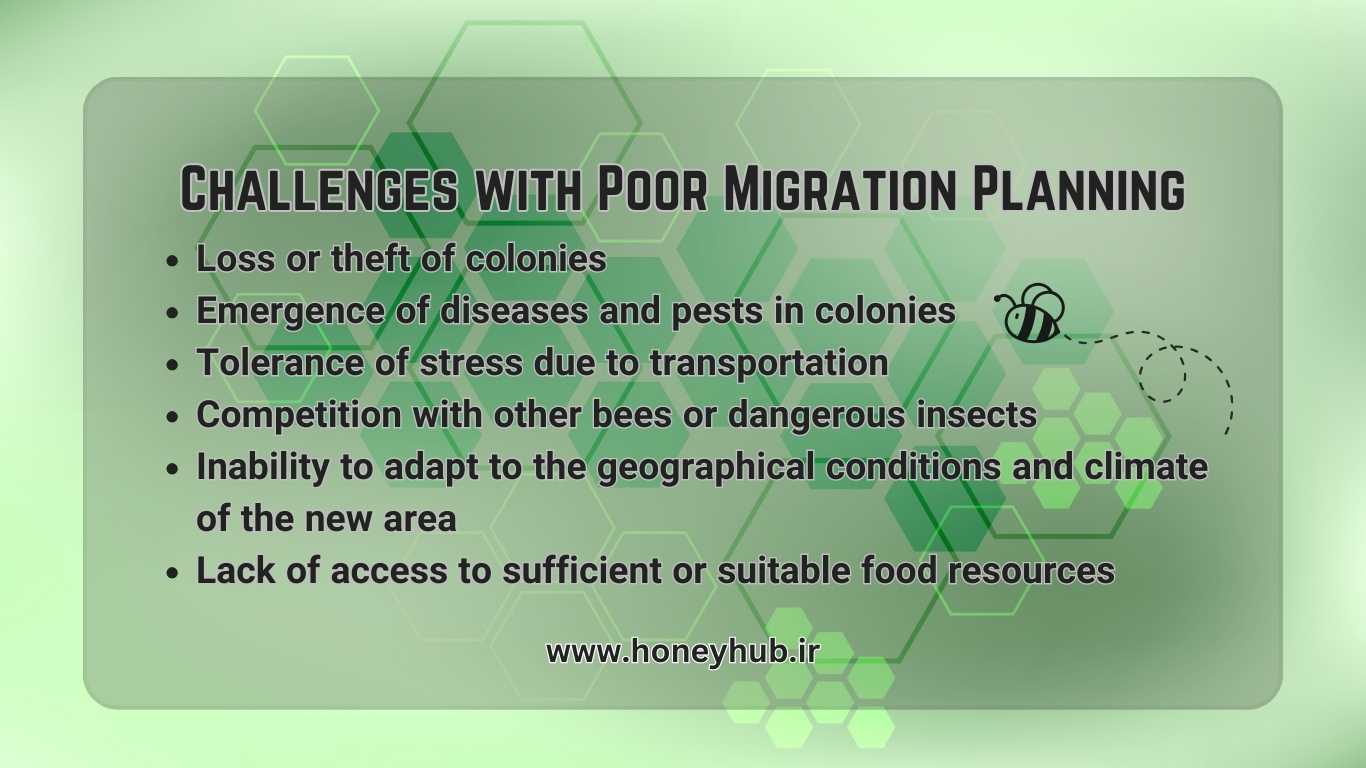
Pre-migration measures
If you are a beekeeper, however experienced you are, still evaluate the following items. give Usually, some actions must be taken before migrating to the desired area. There is nothing wrong with beekeeping. Choosing the wrong place, and not following the immigration tips may cause extremely serious problems for us. We have to lighten and weigh everything before moving.
The right mood for moving
Beekeeping comes with different issues and challenges. Considering moving away from the warm environment of the family, you should try to resolve the issues at home to move safely. Koch creates many problems with the restless mind. Despite very good planning, your mood may present challenges when you face a new place and a new climate. You should rest well before moving. Make various arrangements.
Obtaining a migration permit
According to the current laws of the country, you must have a migration permit for the origin and destination. According to the law of the comprehensive animal husbandry system, you must receive the letter of migration so that in case of dispute, you will not be forced to migrate. The process of obtaining a letter is usually easy. You go to the agricultural Jihad of the city of Mabada and a letter will be written, and after following up and obtaining a permit, you can move without any problems. strong> First of all, you should carefully research the geographical area you are planning to move to. Considering that we assume that you have made your evaluations for Koch and have chosen the Koch destination, we will not go into its details, but it should be noted that the geographical area of Koch has suitable conditions, which include:
Presence of nectar-producing plants or pollen sources: Geographical area The field should have nectar-producing plants or a source of pollen that can meet the needs of bees for food. These plants must have nectar and pollen of the right quality and quantity and have a proper distribution during the season. Some of the nectar-producing plants and pollen sources in Iran are citrus fruits, juniper, sunflower, fennel, thyme, canola, licorice, etc. Of course, you should also pay attention to drought conditions and climate changes. All years are not the same. Considering the high costs of moving, contact your friends or experts in livestock affairs in the relevant cities before moving. Usually, if they are fresh, you will get good advice.
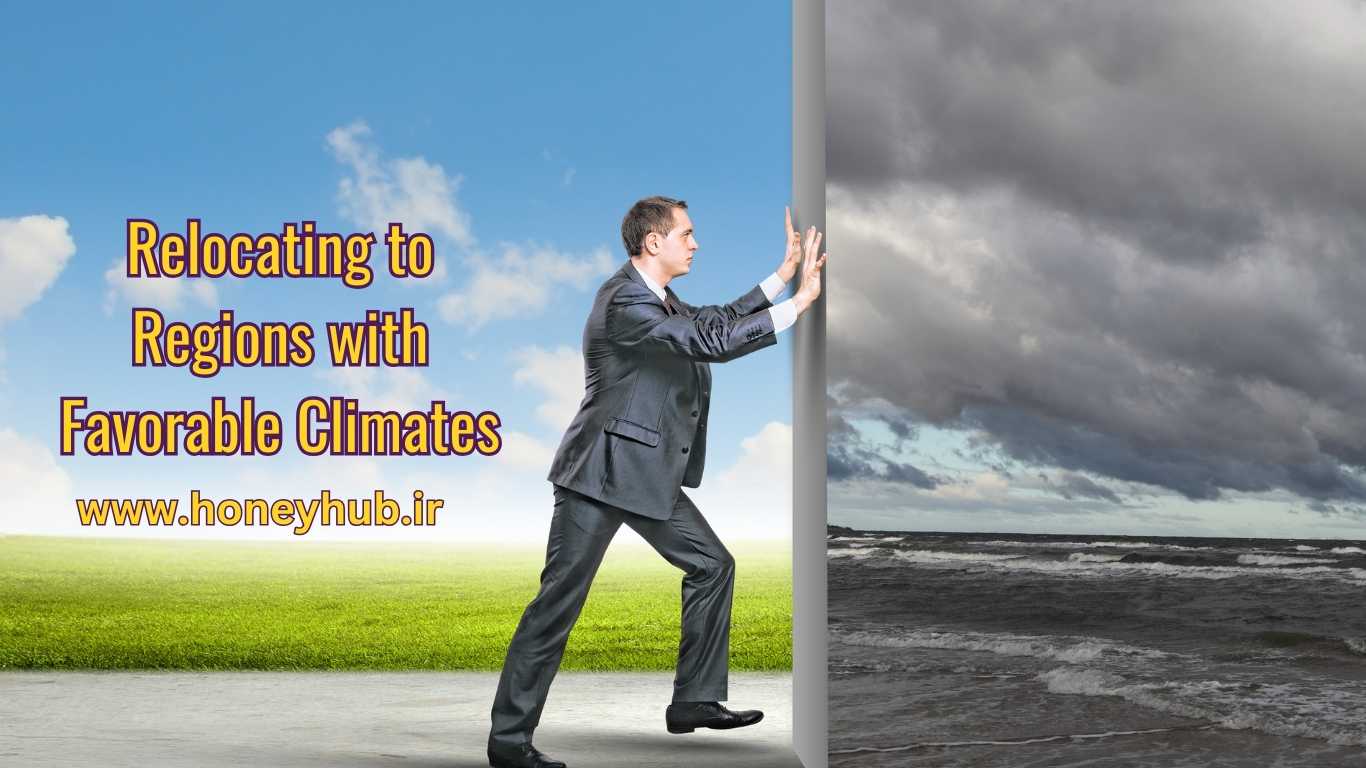
Suitability of weather conditions: The geographical area of Koch should have suitable weather conditions for bees These conditions include air temperature, humidity, wind, precipitation, etc. It should be noted that the air temperature for the activity of bees should be around 15 to 35 degrees Celsius. Air humidity should not be too high or too low. Wind can also prevent bees from flying. Rain may also damage the flowers and their nectar. In the past years, some colleagues have moved without considering this case, and they returned to their province with disappointment. The previous assessment will promise a sweet migration.
Area security: The geographical area of migration should have enough security to protect the colonies. This security includes preventing colonies from being destroyed or stolen, preventing attacks by dangerous insects such as ants, cockroaches, worms, etc., preventing competition with other bees such as red bees or bees from other beekeepers, etc. Koch has special security risks in some provinces. It is necessary to evaluate the security of the area before moving. Avoid taking valuables, and expensive mobile phones to beekeeping tents! Some beekeeping colleagues in some southern provinces have lost their valuables to armed robbers.
Suitable distance: Geographical area of Kuch, should be in be at a suitable distance from the previous location. The proper distance means a sufficient distance to be able to reach there comfortably and economically, and also not a small distance that causes bees to cross with old colonies. If you migrate over long distances, you should open the flight hatch every few hours for ventilation. Although some standard beehives have the possibility of good ventilation, however, you should avoid fatigue.Dryness or heat inside the hive is prevented by geographical changes during travel. It must have the necessary facilities for keeping beekeeping, such as water, shade, road, etc. These facilities can easily and quickly help you in transporting, storing, and producing honey. Of course, you have to calculate with yourself whether it is profitable to migrate to areas with fewer facilities or not. ;">
Check Colony Health: Before migrating, you should check the health of your colonies. This check includes the following:
Number and weight of colonies: Beekeepers should measure the number and weight of their colonies before migration. This allows them to determine how many colonies they can safely carry and how many they should leave in place. It also allows them to compare how much honey they have produced and how much honey is left in the colonies. For this purpose, accurate and electronic scales can be used.
Counting and checking bees: Beekeepers should count and check their bees before migration. Do. This allows them to determine if the bees are suffering from diseases or pests. It also allows them to measure and improve the level of activity, population growth, production of honey and royal jelly, pollination, etc. For this purpose, different methods can be used, such as counting under the microscope, counting in the opening of the colony, counting using electronic devices, etc. Of course, use the method of estimating the population in each frame.
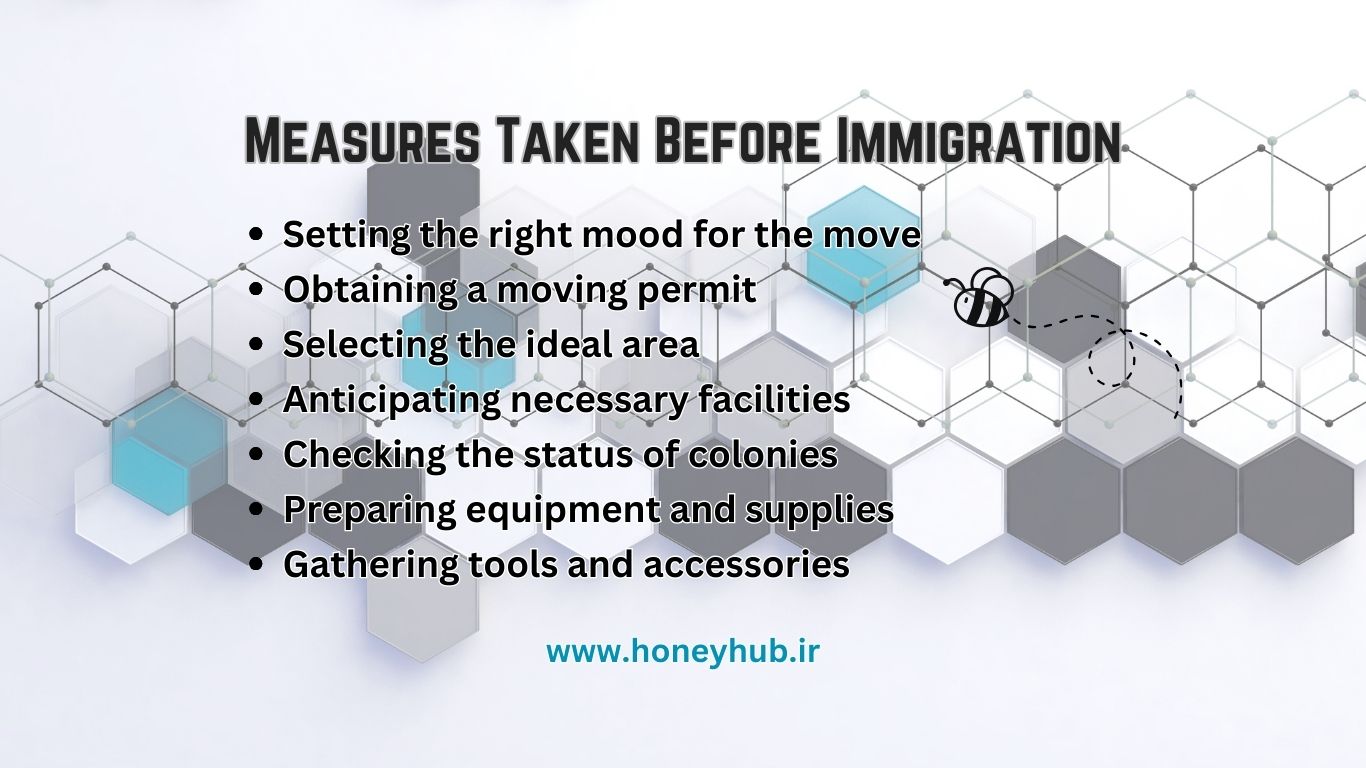
Checking the presence and health of the queen: Beekeepers should check the presence and health of their queen before migration. Review. This allows them to ensure that the queen is laying eggs properly and is not diseased or injured. It also allows them to replace feed or protect or display... the queen if needed. For this purpose, different methods can be used, such as checking eggs, checking larvae, checking the queen with eyes, checking the queen using electronic devices, etc.
Check the nutritional status of the colonies: Beekeepers should check the nutritional status of their colonies before migration. This allows them to determine how much food is available in the colonies and how much food they need to migrate. It also makes them able to feed the colonies with the right food if needed. For this purpose, different methods can be used, such as checking the weight of colonies, checking honey and pollen reserves, checking the activity of bees in collecting food, etc.
Preparation of equipment and supplies
Before migrating, you should prepare your equipment and supplies. This equipment and supplies include the following:
- Colony preparation: Beekeepers must prepare their colonies for transport. to prepare This preparation includes the following:
- Closing the cover of the colony: Beekeepers should close the cover of the colony using wood, plastic, foam, cloth, etc. to prevent bees from leaving or entering. This will prevent the bees from getting stressed during transportation and also prevent the bees from crossing with other colonies. Lock using glue, wire, screws, etc. to prevent the colony from moving or collapsing. This will keep the colony intact while in transit and also prevent the hive from spilling out of the hive. In the long distance, some colleagues use nails to close the hives, which, of course, damages the hive and shortens its life.
Preparation of labels and numbering: Beekeepers should prepare appropriate labels for their colonies and use them clearly and Number them legibly. This allows them to easily identify and categorize their colonies during transport and in the new location. It also allows them to record information about colonies in tags and inform others. For this purpose, you can use plastic, wooden, metal, etc. tags.
Preparation of hives and pallets: Beekeepers should prepare hives and pallets Prepare the right place to place your colonies. This allows them to place their colonies firmly and securely in the hives and pallets and prevent them from falling or slipping. It also allows them to provide proper space between the colonies and prevent them from coming into close contact with each other or with the walls of the box or pallet. For this purpose, wooden, metal, plastic boxes, and pallets can be used. Use proper chains to connect your hives and pallets during transportation. This allows them to keep their hives and pallets portable and changeable during transportation and avoid vibration or damage caused by transportation. For example, you can use metal or plastic or fabric straps or chains. Preparation of fabrics and covers: Beekeepers should prepare suitable fabrics and covers to cover their colonies. This allows you to protect your colonies from light, heat, cold, wind, rain, etc., and keep them easily during transportation. It also allows you to keep your colonies in a secret location and avoid the attention of others. For this purpose, white, green, brown, gray, etc. fabrics and covers can be used.
Preparation of necessary water and food: Beekeepers must prepare the necessary water and food to feed their colonies during transportation. This allows them to meet the bees' need for water and food on the way and prevent them from being dry or hungry. It also allows them to prepare the bees for new conditions and prevent them from reducing their activity or production. For this purpose, you can use pure water, sugar, honey, pollen, protein, etc.
Preparation of tools and accessories
Beekeepers must prepare the necessary tools and accessories for transporting and maintaining their colonies. These tools and accessories include the following:
- Preparation of means of transport: beekeepers must have means of transport and Prepare suitable transport for transporting your colonies. These means of transportation can include cars, trailers, trucks, tractors, etc. It should be noted that the means of transportation must have enough space, proper ventilation, reasonable speed, skilled driver, etc.
- Preparation of beekeeping tools: Beekeepers must have the necessary beekeeping tools. prepare for storage and production of honey in the new place. These beekeeping tools can include beekeeping clothing, a chimney, a hammer, a knife, queen cage, honey separator, honey wheel, etc. Preparation of medicines and detergents: beekeepers should prepare the necessary medicine and detergents to prevent and treat diseases and pests in their colonies. This medicine and detergents can include antibiotics, oxalic acid, formic acid, thymol, lactic acid, acetic acid, etc.
Measures during migration
Choosing the right time
Beekeepers should choose the right time for migration. This time should be such that:
coordinate with the season and flowering: Beekeepers should perform the migration at a time that is in harmony with the season and flowering of the geographical area of migration. This work allows them to make more use of nectar-producing plants and pollen sources, and as a result, increase the production of honey and royal jelly, pollination, and the growth of their population.
According to the weather conditions: Beekeepers should perform the migration at a time that is by the weather conditions of the geographical area of migration. This work allows them to reduce the stress caused by changes in temperature, humidity, wind, rain, etc. for bees and thus maintain their health and performance.
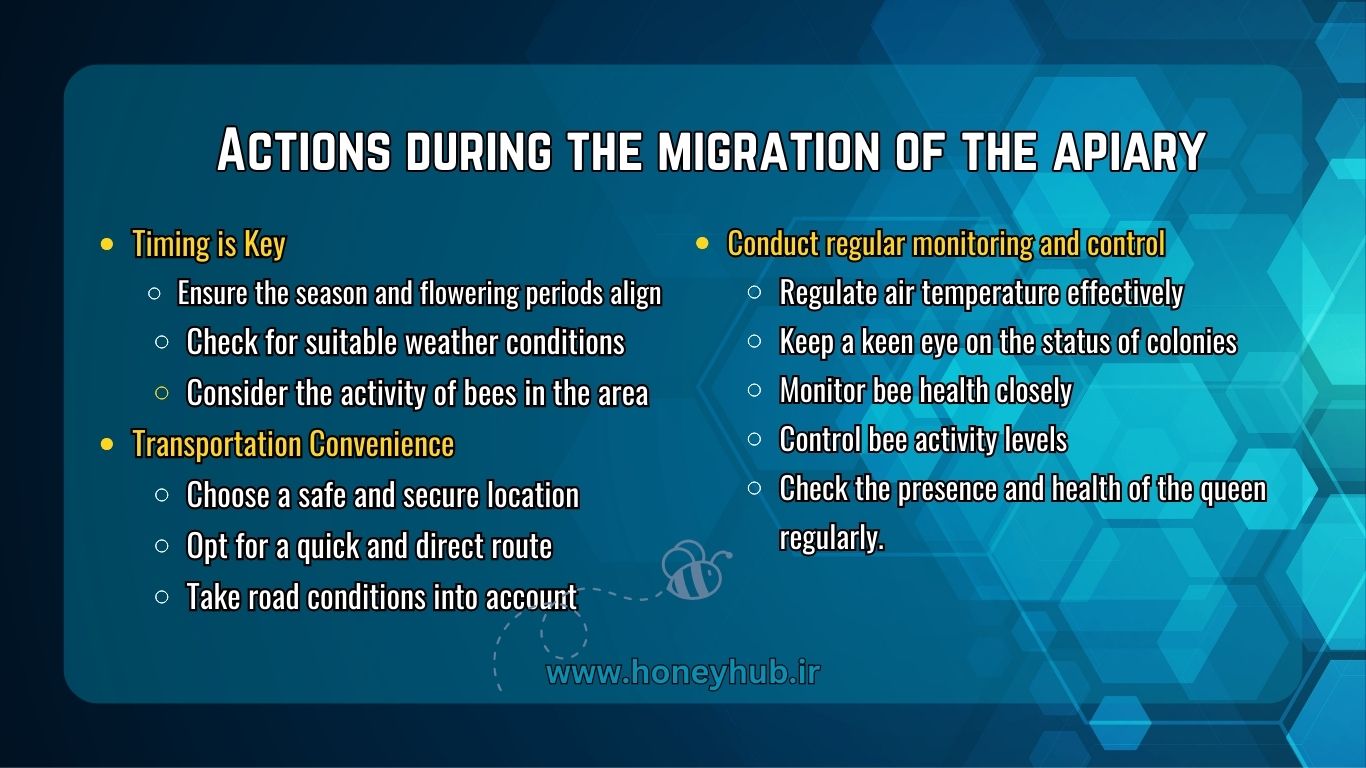
be suitable for bees' activity: beekeepers should perform migration at a time that is suitable for bees' activity. This makes it possible to prevent bees from leaving or entering during transport thus preventing bees from crossing with other colonies. In addition, it makes it possible to prevent bees from getting tired or dry. In general, it is better to migrate in spring, autumn, or at night.
Suitable transportation
Beekeepers need to make proper transportation for migration. This transportation must be:
safe and secure: Beekeepers must transport in a way that is safe and secure. This work makes it possible to prevent falls or slips accidents theft or destruction of colonies and thus protect the health and performance of bees.
Quick and short. Be: Beekeepers should carry out the transport in such a way that it is quick and short. This allows them to reduce the transportation time and thus reduce the stress caused by transportation for the bees, as well as to reach the new area sooner and use its food resources.
Conform to the road conditions: Beekeepers must carry out transportation in a manner that is in accordance with the road conditions. This work makes it possible to avoid problems caused by bad roads, full of traffic, full of potholes, etc., and as a result, vibration or injuries caused by transportation can be prevented.
Regular control and supervision
Beekeepers must carry out regular control and supervision on transportation. This allows them to identify and fix or prevent possible problems or risks during transportation. Some of the things that should be controlled and monitored are:
- Temperature control: Beekeepers should take the air temperature-control during transportation. This will prevent the air from getting too hot or too cold, and beekeepers should control the air conditioning during transport. This work makes it possible to prevent the accumulation of toxic gases or lack of oxygen in the air, and thus prevent bees from becoming tired or dry or dying. It should be noted that the air conditioning should be regular and balanced.
- Control of the condition of the colonies: Beekeepers should control the condition of their colonies during transportation. This allows them to identify and fix or prevent possible problems or risks during transportation. Some of the things that should be controlled are
- Bee health control: Beekeepers should monitor the health of their bees during transportation. This allows them to determine if the bees are suffering from diseases or pests. It also makes them able to inject or spray or place appropriate medicine or detergent to the bees and treat or prevent or...
- Bee activity control: Beekeepers should control the activity of their bees during transportation. This allows you to tell if the bees are flying or resting or producing honey or... It also makes you able to feed or cover the bees with water or food or suitable cloth or cover if needed and change their activity or stress or production.
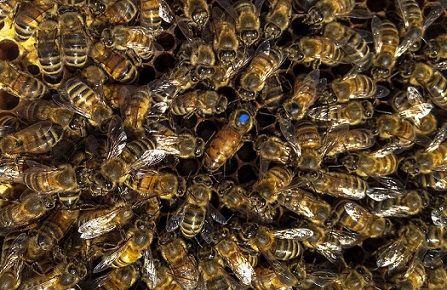
- Queen presence and health control: Beekeepers must monitor the presence and health of their queen during transportation. This allows them to ensure that the queen is laying eggs properly and is not diseased or injured. This allows you to replace feed or protect or display... the queen if needed. Of course, this part is when you are on the road for several days and nights and you have to give the bees a little rest.
Actions after migration and reaching the place of migration
choosing the right place
Beekeepers must choose the right place to place their colonies in the new area. This place should be in such a way that
- it is close to the nectar-producing plants or pollen source: beekeepers should choose the place in such a way that it is close to the nectar-producing plants and the source is pollen This will allow them to make more use of nectar-producing plants and pollen sources, and as a result, increase the production of honey and royal jelly, pollination and the growth of their population.
According to Adapt to the climate: Beekeepers should choose a location that suits the climate of the new geographic area. This work allows them to reduce the stress caused by changes in temperature, humidity, wind, rain, etc. for bees and thus maintain their health and performance.
Be safe and secretive: Beekeepers should choose a location that is safe and secretive. This allows them to prevent their colonies from being lost stolen or attacked, thereby protecting the health and performance of the bees.
Placing colonies in the right place: Beekeepers need to place their colonies in the right place in the new area. This placement should be:
Oriented: Beekeepers should position their colonies in such a way that they have the proper orientation. This direction should be such that:
facing the sun: beekeepers should place their colonies in such a way that they face the sun. This allows them to wake up earlier and start their activities, thus increasing the production of honey and royal jelly, pollination, and the growth of their population.
Back to the wind: Beekeepers should position their colonies with their backs to the wind. This work makes it possible to prevent cold or hot wind from entering the colony, thus preventing bees from becoming tired dry, or dying.
- Have proper distance: Beekeepers should place their colonies in such a way that they have proper distance. This distance should be
Sufficient: Beekeepers should place their colonies in such a way that there is sufficient distance between them. This work allows them to prevent bees from competing or crossing with other colonies, thus preventing the reduction of honey and royal jelly production, pollination, and the growth of their population.
Not short: Beekeepers should place their colonies in such a way that there is no short distance between them. This work allows them to prevent the bees from moving away from their colony, thus preventing bees from becoming tired or dry or dying.
According to the number and size Colonies should be: Beekeepers should place their colonies in such a way that the distance corresponds to the number and size of their colonies. This work allows them to provide the right environment for the activity and production of their bees and thus maintain or improve their health and performance.
Placing fabrics and Covers
Beekeepers should place their fabrics and covers over their colonies in the new area. This allows them to protect their colonies from light, heat, cold, wind, rain, etc., and keep them easy to maintain. It also allows them to keep their colonies in the new location in secret and avoid the attention of others. For this purpose, you can use white, green, brown, gray, etc. fabrics and covers. Sometimes some colleagues use leaves and grass for cover, which has its advantages and disadvantages. You have to control the feeding and water of your colonies in the new area. This will make your bees meet their need for water and food in the new place and prevent them from being dry or hungry. It also allows them to prepare the bees for new conditions and prevent them from reducing their activity or production. For this purpose, you can use pure water, sugar, honey, pollen, protein, etc.
Connecting with other beekeepers
Beekeepers should communicate with other beekeepers in the new area. This allows them to benefit from the experience and knowledge of other beekeepers and thus improve their activity and production. It also makes them able to cooperate or interact or have healthy competition with other beekeepers. For this purpose, you can use different methods such as phone calls, SMS, email, social networks, etc.
Take care of the environment
Beekeepers should protect the environment. Observe during transportation. This makes it possible to prevent pollution or destruction of the environment and thus avoid legal or ethical complications. For example, you can use the following methods:
Collection of waste: Beekeepers should collect their waste during transport and dispose of it in a suitable place. do This makes it possible to prevent waste from being scattered in the environment and thus prevent pollution or destruction of the environment.
Reduction of annoying noise: Beekeepers should reduce noise. Reduce disturbance during transportation. This allows them to avoid stimulating or destroying their own or others' colonies, thus preventing stress or producing less honey. They are the continuation of our beekeeping life. We all take care of the environment in the forest or desert. At the time of Koch, but more. Because we are guests we must respect the host, the forest, and the desert. We are lovers of nature and lovers of nature's flowers and plants. So let's respect our life cycle.
Observe the rules and regulations
Beekeepers must follow the rules and regulations related to environmental protection during transportation. These rules and regulations may include licenses, reports, inspections, fines, obligations, etc. These rules are written to support, protect, and support us. Let's respect the laws so that we all have the possibility of healthy and competitive activity.
Conclusion
Emigration management is one of the requirements of industrial and modern cultivation. One of the methods that beekeepers use is to make more use of nectar-producing plants and pollen sources, to produce quality honey and strengthen their colonies. But this method also requires careful planning and management. In this post, we discussed some necessary measures before, during, and after immigration. These measures include choosing the right area and location, checking the health and condition of the colonies, preparing equipment and supplies, proper transportation, regular control and monitoring, feeding and water supply of the colonies, communicating with other beekeepers, protecting the environment, and respecting the laws. These actions can help us beekeepers to make the migration successful and healthy and as a result, improve our activity and production.
Dear colleague, good luck in your migration!
Leave a comment
Log in to post comments





















Latest comments